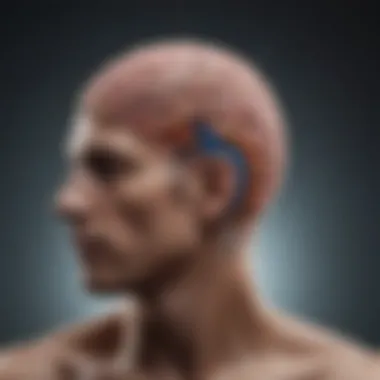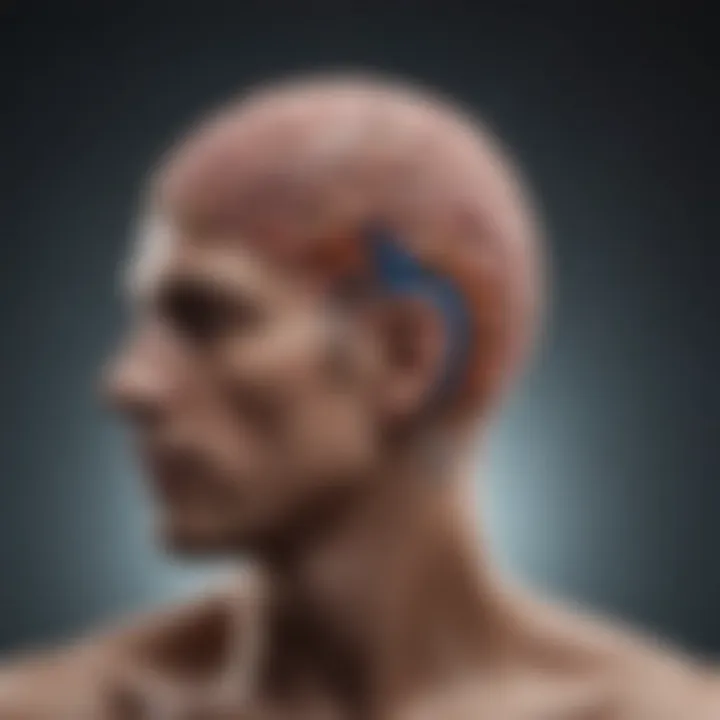Understanding Amygdala Anxiety Treatment Options


Intro
Anxiety disorders affect millions of people worldwide, exacerbating daily life challenges. Central to our understanding of these disorders is the amygdala, a region of the brain that plays a crucial role in processing emotions. The intricate relationship between the amygdala and anxiety highlights the need for targeted treatment approaches. Recent advancements in both pharmacological and psychological treatments offer a nuanced view of managing anxiety.
This article aims to explore various mechanisms behind amygdala-related anxiety, examining treatments like medications, cognitive-behavioral therapy (CBT), and innovative therapeutic techniques. By understanding how these approaches interact with the amygdala’s functions, we can better appreciate their effectiveness and limitations.
Key Findings
Summary of the main results
Recent studies reveal that the amygdala is highly sensitive to various stressors, influencing the body's fear response. Medications like selective serotonin reuptake inhibitors (SSRIs) and benzodiazepines have shown effectiveness in modulating amygdala activity. Cognitive-behavioral strategies also target maladaptive thought patterns, offering significant relief to those suffering from anxiety disorders.
Furthermore, emerging therapies, such as neurofeedback and transcranial magnetic stimulation (TMS), demonstrate potential in reducing amygdala hyperactivity. Collectively, these treatments provide a multi-faceted approach to anxiety management, yet they come with different efficacy rates and side effects.
Significance of findings within the scientific community
These findings contribute to a growing body of knowledge regarding the biological underpinnings of anxiety. Understanding amygdala function in anxiety disorders paves the way for more personalized and effective treatment modalities. Researchers continue to investigate how targeting specific neurobiological mechanisms can lead to improved outcomes in anxiety treatment.
Implications of the Research
Applications of findings in real-world scenarios
The implications of this research extend beyond academia. Clinicians can apply these insights when developing treatment plans, tailoring interventions to suit individual patient profiles. For instance, someone with significant amygdala reactivity may benefit from a combination of medication and CBT that directly address their fear response.
Potential impact on future research directions
Future research will likely focus on refining these therapies and exploring the role of genetic and environmental factors in anxiety disorders. Investigations into novel treatment methods, such as virtual reality exposure therapy, promise to forge new paths in addressing the complex nature of anxiety. As we deepen our understanding of the amygdala's role, the potential for innovative treatment strategies becomes ever more promising.
"A thorough understanding of the amygdala's functions in anxiety opens doors to more effective therapeutic strategies."
Prolusion to the Amygdala and Anxiety
The interplay between the amygdala and anxiety is a focal point of this article. Understanding this link is crucial, as the amygdala plays a significant role in regulating emotions, particularly fear and anxiety. It is essential to grasp how anxiety disorders manifest in the context of amygdala function, which sets the groundwork for exploring various treatment methods.
Many individuals experience anxiety at different levels, but when it becomes a disorder, it can severely affect daily life. This article aims to dissect the involvement of the amygdala in these disorders, shedding light on evidence-based treatments ranging from pharmaceuticals to psychotherapeutic methods. By examining these connections, we facilitate a conversation about better management of anxiety symptoms.
Understanding the Amygdala
The amygdala is an almond-shaped cluster of nuclei located deep within the temporal lobes of the brain. Its primary function is to process emotions, notably fear and pleasure.
- It consists of several components: the lateral amygdala, the basal amygdala, the central nucleus, and the medial amygdala. Each segment contributes differently to emotional regulation, memory processing, and decision-making.
- The amygdala is highly connected to other brain regions, notably the prefrontal cortex, hippocampus, and hypothalamus.
Alterations in amygdala activity can lead to heightened emotional responses and influence behavior. For instance, overactivity is often observed in individuals with anxiety disorders. Understanding how the amygdala functions can provide insights into the mechanisms underlying anxiety and the effectiveness of various treatment options.
The Role of the Amygdala in Anxiety Disorders
Anxiety disorders include generalized anxiety disorder, panic disorder, and social anxiety disorder among others. The amygdala's response to perceived threats plays a pivotal role in these conditions. It can initiate a stress response, triggering the release of stress hormones like cortisol.
Research indicates:
- Individuals with anxiety disorders often exhibit increased amygdala activation when presented with anxiety-related stimuli.
- This hyperactivity can lead to exaggerated responses to stress, making even minor situations feel overwhelming.
Understanding the specific role of the amygdala in these disorders helps clarify why certain treatments may be effective. Knowledge of amygdala dynamics provides a solid foundation for developing therapeutic strategies, thus addressing the pathology of anxiety at a neurobiological level.
In summary, the intricacies of the amygdala's function in anxiety disorders underscore the necessity for targeted treatments. The following sections will delve into various therapeutic approaches and their relation to amygdala function.
Neurobiology of Anxiety
The neurobiology of anxiety is a crucial aspect of understanding how anxiety disorders develop and are treated. Within the context of this article, it highlights the intricate relationships between brain structures, particularly the amygdala, and the physiological responses to stress. Understanding this interplay provides insights into how specific treatments can modulate these responses, leading to effective anxiety management.
Exploring the neurobiology of anxiety not only informs clinical practices but also enriches ongoing research in the field. Given that anxiety affects a significant portion of the population, comprehending its biological foundations can lead to improved therapeutic interventions and more informed approaches for patients.
The Amygdala and the Stress Response
The amygdala plays a central role in the brain's stress response. This almond-shaped cluster of nuclei is essential for emotional processing and is particularly sensitive to perceived threats. When an individual encounters a potential danger, the amygdala signals the release of stress hormones, such as cortisol and adrenaline, preparing the body for a rapid response. This process is fundamental for survival but can become maladaptive in cases of chronic anxiety.
Research has shown that an overactive amygdala correlates with heightened anxiety levels. In conditions where the amygdala is excessively reactive, individuals may exhibit hyper-vigilance and exaggerated fears. This dysfunction becomes vital to consider when discussing treatment options since targeting the amygdala's activity can potentially alleviate anxiety symptoms.
Neurotransmitter Systems Involved in Anxiety
The neurobiology of anxiety is influenced by various neurotransmitter systems. Important players include serotonin, norepinephrine, and gamma-aminobutyric acid (GABA). Each of these neurotransmitters has distinct roles in mood regulation and anxiety.


- Serotonin: Often associated with mood stabilization, serotonin imbalance has been linked to anxiety disorders. Selective serotonin reuptake inhibitors (SSRIs) are commonly prescribed to restore balance.
- Norepinephrine: This neurotransmitter is crucial for the body’s stress response. Dysregulation may lead to heightened anxiety and panic attacks.
- GABA: Known as an inhibitory neurotransmitter, GABA's function is to reduce neuronal excitability, thus promoting relaxation and calmness.
Understanding how these neurotransmitters interact within the amygdala and broader anxiety pathways is essential for developing targeted pharmacotherapies.
Genetic Influences on Amygdala Function
Genetics also play a significant role in the functioning of the amygdala and the predisposition to anxiety disorders. Certain genetic variations may impact how individuals respond to stress and process emotional stimuli.
Research has identified specific gene polymorphisms, such as those related to serotonin transport, that modulate amygdala activity. This genetic backdrop could explain why some people develop anxiety disorders while others do not under similar circumstances.
- Familial Patterns: Anxiety disorders often run in families, indicating a genetic component in their development.
- Gene-Environment Interaction: An individual’s environment can influence the expression of genetic predispositions. Stressful life events may trigger the onset of anxiety in genetically susceptible individuals.
By understanding these genetic influences, healthcare providers can better personalize treatment approaches, offering interventions that align with individual biological profiles.
Diagnostic Framework for Anxiety Disorders
A diagnostic framework for anxiety disorders is essential for ensuring that individuals receive accurate assessments and effective treatments. It allows mental health professionals to recognize the various symptoms and manifestations of anxiety, tailoring interventions to each patient's unique needs. This framework also aids in distinguishing anxiety disorders from other conditions that may present with similar symptoms, such as mood disorders or personality disorders. By enhancing diagnostic accuracy, the framework supports more effective management strategies.
Clinical Assessment Techniques
Clinical assessment techniques are pivotal in diagnosing anxiety disorders. The use of structured interviews and standardized questionnaires can significantly improve the reliability of diagnoses. Common tools include the Hamilton Anxiety Rating Scale and the Beck Anxiety Inventory, which help quantify symptom severity.
Another crucial element is clinician observation during the assessment process. This may involve evaluating the patient's behavior, emotional responses, and physical manifestations of anxiety, all of which contribute to a thorough understanding of their condition.
Consideration must also be given to the patient's history. Understanding any previous mental health issues, family history of anxiety disorders, and the impact of stressors in their life can provide invaluable context.
The Role of Neuroimaging in Diagnosis
Neuroimaging plays a growing role in the diagnostic process for anxiety disorders. Using techniques such as functional magnetic resonance imaging (fMRI) and positron emission tomography (PET), researchers can observe the brain's activity and structure in individuals with anxiety. These technologies help identify abnormal patterns in the amygdala and other brain areas implicated in emotional regulation and stress response.
For instance, studies using neuroimaging have shown that individuals with anxiety disorders may exhibit increased amygdala activation when confronted with threatening stimuli. This finding supports the idea that hyperactivity in the amygdala is a robust marker of anxiety.
Incorporating neuroimaging into the diagnostic framework can enhance traditional clinical assessments, helping clinicians identify specific brain-related issues that may contribute to anxiety. This approach can guide treatment decisions and provide insight into the neurobiological underpinnings of anxiety disorders.
"A comprehensive diagnostic framework integrates clinical assessment and neuroimaging, enabling better-informed treatment strategies for anxiety disorders."
Pharmacological Treatments for Amygdala-Related Anxiety
Pharmacological treatments are crucial in addressing anxiety that stems from dysregulation in the amygdala. These treatments can offer significant relief to those suffering from anxiety disorders. Understanding the various mechanisms, types, and their implications is vital for making informed choices in treatment strategies. The role of pharmacological interventions transcends merely alleviating symptoms; it touches on adjusting neural activity in the amygdala, enhancing the effectiveness of therapeutic engagement, and enabling better overall life management for individuals impacted by anxiety.
The ongoing evolution in pharmacological options also represents an essential aspect of anxiety treatment, as specific medications can target various neurotransmitter systems that may be assosiated with anxiety-related conditions. Thus, recognizing how they work and their therapeutic benefits becomes fundamental for healthcare professionals, educators, and researchers.
Antidepressants and Their Mechanisms
Antidepressants are often utilized to manage anxiety disorders. Selective serotonin reuptake inhibitors (SSRIs) are particularly common. Medications like sertraline, escitalopram, and fluoxetine target serotonin pathways. They increase serotonin levels in synaptic clefts by preventing its reabsorption. This enhancement in neurotransmission can alter the amygdala's responsiveness to stress and fear stimuli.
Furthermore, serotonin plays a significant role in emotion regulation. By modulating the input to the amygdala, SSRIs may reduce activation in this region during anxious episodes.
The efficacy of antidepressants often comes with several considerations:
- Onset of effects: Unlike some medications that provide immediate relief, antidepressants may take weeks to reach their full impact.
- Side effects: Patients may experience weight gain, sexual dysfunction, or gastrointestinal disturbances.
- Long-term use: Assessment of benefits versus potential long-term side effects must be carefully managed.
Anxiolytics: Understanding Benzodiazepines and Alternatives
Benzodiazepines are another class of medications frequently prescribed for anxiety disorders. Diazepam, lorazepam, and alprazolam work by enhancing the effects of gamma-aminobutyric acid (GABA), the primary inhibitory neurotransmitter in the brain. This action reduces the excitability of neurons in the amygdala and ultimately results in a calming effect.
While benzodiazepines can provide quick relief from acute anxiety, their long-term use poses challenges:
- Dependence risk: Prolonged use can lead to physical dependence and withdrawal symptoms.
- Cognitive impact: Chronic use may affect memory and cognitive functioning.
Alternatives to benzodiazepines, such as buspirone, offer another option. This medication targets serotonin receptors and provides anxiolytic benefits without the dependence risk associated with benzodiazepines.
Emerging Pharmacotherapies
The landscape of anxiety treatment continuously evolves, with emerging pharmacotherapies exhibiting promise. Novel approaches are under research that aims to address various dimensions of anxiety disorders. For example, ketamine, an anesthetic agent, has shown rapid reduction in anxiety symptoms in certain contexts. It appears to work differently than traditional antidepressants, rapidly modulating glutamate activity, which is integral to synaptic plasticity and mood regulation.
Another area of interest is cannabinioids. Some research suggests that compounds like CBD may help alleviate anxiety without the psychoactive effects of THC. Ongoing studies aim to define dosing, efficacy, and safety profiles.
Ultimately, while pharmacological treatments play a substantial role in managing amygdala-related anxiety, they are most effective when combined with psychotherapeutic approaches and lifestyle changes. This integrative approach fosters a more comprehensive strategy to anxiety management.
Psychotherapeutic Approaches


Psychotherapeutic approaches occupy a significant role in addressing amygdala-related anxiety, providing a foundation for many individuals seeking relief from their emotional struggles. These therapies are designed to help people manage their anxiety symptoms, uncover their underlying causes, and promote adaptive coping mechanisms. The focus on the amygdala is essential as it plays a crucial part in emotional regulation, which can often be impaired in individuals suffering from anxiety disorders. Understanding how psychotherapeutic methods interact with amygdala function can optimize treatment outcomes and enhance the efficacy of these therapeutic interventions.
Cognitive Behavioral Therapy (CBT) and the Amygdala
Cognitive Behavioral Therapy (CBT) is a well-researched and widely utilized treatment for anxiety disorders. It operates on the principle that our thoughts influence our emotions and behavior and aims to modify negative thought patterns that may be contributing to one's anxiety. CBT targets the amygdala indirectly by helping patients reframe their cognitive distortions, which can lower the amygdala's hyperactive response to perceived threats.
- Key Features of CBT:
- Identification of negative thinking patterns
- Development of coping strategies
- Behavioral interventions, such as exposure
The efficacy of CBT can often improve emotional regulation and reduce anxiety symptoms substantially. Studies suggest that CBT can contribute to changes in amygdala activity, helping individuals process anxiety-triggering stimuli more effectively. This can lead to one’s ability to respond to stressors with more resilience and less hyperactivity in the amygdala.
Exposure Therapy: Mechanisms and Efficacy
Exposure therapy is a specific form of CBT that involves gradual exposure to anxiety-inducing situations or stimuli. The goal is to desensitize patients and reduce their fear response over time. The mechanisms underlying exposure therapy are thought to influence amygdala function directly. By confronting fears in a controlled environment, individuals learn that their fears are often unfounded, leading to changes in amygdala reactivity.
- Mechanisms:
- Habituation: Repeated exposure reduces the fear response.
- Extinction: Learning that the feared stimulus is no longer a threat.
Research highlights the effectiveness of exposure therapy in treating conditions such as phobias, PTSD, and social anxiety. The positive changes in amygdala function during therapy often correlate with reduced anxiety symptoms, making exposure therapy a valuable tool in managing anxiety disorders.
Mindfulness and Acceptance-Based Approaches
Mindfulness and acceptance-based approaches have gained attention in recent years as useful treatments for anxiety. These techniques encourage individuals to observe their thoughts and feelings without judgment, promoting acceptance of emotional experiences rather than avoidance. This process can modulate amygdala activity by fostering a more balanced response to anxiety-driven thoughts.
- Key Aspects of Mindfulness:
- Non-judgmental awareness of the present moment.
- Acceptance of thoughts and feelings as they are.
Practices like mindfulness meditation have shown promise in reducing anxiety and stress levels, leading to more regulated amygdala function. Studies indicate that these practices may achieve both structural and functional changes in the amygdala over time, leading to better emotional resilience and coping strategies.
"The integration of psychotherapeutic approaches, particularly those focused on the amygdala's mechanisms, can greatly enhance treatment effectiveness for individuals facing anxiety disorders."
The Role of Lifestyle Interventions
Lifestyle interventions play a crucial role in the treatment and management of anxiety. This section aims to highlight how certain lifestyle choices can significantly impact the functioning of the amygdala and influence anxiety levels. The importance of these interventions is not just in their application but also in understanding their effects on mental health.
Several factors contribute to anxiety disorders, and lifestyle has emerged as a vital component. Incorporating regular exercise, maintaining a balanced diet, and ensuring sufficient sleep can help in managing anxiety more effectively. Researchers increasingly recognize that these aspects are interconnected, influencing not only the individual's physical health but also their emotional and psychological well-being.
By focusing on lifestyle changes, patients may experience a reduction in anxiety symptoms. This approach can enhance the efficacy of traditional therapies, leading to a more comprehensive treatment plan. In addition to providing physical benefits, such interventions can improve overall mental resilience against stressors, which is beneficial for individuals struggling with anxiety-related disorders.
Exercise and Its Effects on Amygdala Function
Exercise emerges as a particularly effective lifestyle intervention for managing anxiety. Engaging in physical activity has been shown to influence the amygdala positively. When individuals exercise, the body releases endorphins, which can enhance mood and reduce feelings of anxiety.
Moreover, regular exercise aids in lowering cortisol levels, the hormone often associated with stress. A reduction in cortisol can subsequently lead to a calmer amygdala response. Some studies suggest that aerobic exercise specifically can reshape the neural pathways involved in emotion regulation, potentially leading to improved responses to stressors.
The type of exercise also matters. Continuous, moderate exercise like jogging or swimming is often more beneficial than short bursts of intense workouts. Practicing mindfulness in exercise routines, such as yoga or tai chi, also supports emotional regulation and promotes a relaxation response, contributing to amygdala regulation.
Dietary Considerations for Anxiety Management
Diet plays a pivotal role in mental health, including anxiety management. Certain nutrients can either exacerbate or alleviate symptoms. For instance, omega-3 fatty acids, found in fish like salmon and trout, have been linked to lower levels of anxiety. Conversely, diets high in refined sugars and processed foods have been associated with increased anxiety levels.
Additionally, the inclusion of whole foods, such as fruits, vegetables, whole grains, and lean proteins, can provide vital nutrients that support brain health. Elements like magnesium, zinc, and B vitamins are essential for neurotransmitter function, which directly impacts mood and anxiety responses.
While dietary changes may not replace traditional treatments, they still represent a valuable adjunct approach. Focusing on a balanced diet can improve overall mental health and bolster resilience against anxiety disorders.
Sleep's Impact on Anxiety and the Amygdala
Quality of sleep profoundly affects anxiety levels and the functioning of the amygdala. Poor sleep can heighten emotional reactivity, influencing how individuals process stressors. On the other hand, sufficient and restful sleep can help modulate amygdala activity, leading to a more balanced emotional response.
Research indicates that sleep deprivation can increase the amygdala's response to negative stimuli, which can consequently amplify feelings of anxiety. Therefore, ensuring good sleep hygiene is crucial. This includes maintaining a regular sleep schedule, creating a restful environment, and limiting exposure to screens before bedtime.
Improving sleep quality might not only assist in managing anxiety but can also enhance the efficacy of other treatments. Recognizing sleep's role in anxiety offers a pathway to a more integrated approach to treatment, encompassing both behavioral and physiological aspects.
"By adopting lifestyle interventions, individuals can actively participate in their anxiety management, fostering environments conducive to healing and emotional balance."
In summary, a focus on lifestyle interventions complements traditional treatment approaches in significant ways. Exercise, dietary adjustments, and improved sleep can enhance mental health outcomes and mitigate anxiety, creating a holistic strategy for better management.
Emerging Therapies and Novel Approaches


Emerging therapies and novel approaches in anxiety treatment are gaining attention. This focus reflects a shift in understanding anxiety disorders and how they can be managed. Traditional methods like medication and psychotherapy have shown efficacy but are not always sufficient for every individual. Newer strategies aim to address various aspects of anxiety, connecting neuroscience and clinical practices more deeply. These therapies can work as adjuncts to existing treatments or serve as primary interventions, offering hope for improved outcomes.
Neurofeedback and Biofeedback Techniques
Neurofeedback and biofeedback techniques hold promise in treating anxiety. Neurofeedback is a method that teaches individuals to regulate brain activity. By providing real-time feedback about their brain patterns, patients can learn to control these responses. This process may lead to reduced anxiety symptoms. Studies suggest that it helps in conditions such as generalized anxiety disorder and post-traumatic stress disorder.
Biofeedback, on the other hand, focuses on physiological functions. In this technique, patients receive feedback on bodily signals like heart rate, muscle tension, and skin temperature. Learning to control these responses can empower individuals. It provides tools to manage anxiety when it arises. Both methods require commitment. The practice often takes time but can result in meaningful changes in how patients manage their anxiety.
Psychedelic-Assisted Therapy
Psychedelic-assisted therapy is another area of interest. This approach involves using substances like psilocybin or MDMA in a controlled setting. The substances have shown potential in easing anxiety, especially in those facing terminal illness or severe trauma. Evidence suggests that these therapies can induce profound emotional experiences, leading to long-lasting decreases in anxiety.
While this field of study is still developing, early clinical trials indicate positive outcomes. Patients often report significant therapeutic benefits, such as increased emotional clarity and connection. However, caution must be exercised. The use of psychedelics carries risks and is not for everyone's needs. Proper screening and professional guidance are essential.
Results from ongoing research indicate that the integration of emerging therapies may significantly reshape the landscape of anxiety treatment, offering advanced options for patients not responding to conventional therapies.
In summary, both neurofeedback and psychedelic-assisted therapy represent a significant advancement in addressing anxiety. Each offers unique benefits and challenges. Their ongoing development is important, as they may lead to more comprehensive and individualized treatment approaches in the future.
Challenges in Treatment Implementation
Understanding the challenges in treatment implementation for anxiety disorders related to the amygdala is crucial for developing effective therapeutic strategies. Treatment for anxiety is complex due to various factors impacting patient care, reaction to treatment, and outcomes. Addressing these challenges not only improves the access and effectiveness of treatments but also enhances the overall experience for patients seeking help.
Barriers to Accessing Care
Many people facing anxiety disorders struggle to get the help they need. There are numerous barriers to accessing care that affect patients at different levels. Some of these include:
- Cost of Treatment: Often, mental health services can be expensive, and not all insurance plans adequately cover these costs. This makes treatment inaccessible for many individuals.
- Stigma Around Mental Health: Social stigma plays a significant role in preventing individuals from seeking care. Many worry about being judged or labeled because they have an anxiety disorder.
- Limited Availability of Services: In some areas, especially rural locations, qualified professionals may be scarce. Patients might face long waits to see a provider or may not have any nearby options.
- Lack of Knowledge: Some individuals may not understand the signs of anxiety or the treatment options available to them. This lack of awareness can lead to delays in seeking help.
Addressing these barriers requires a multifaceted approach that involves healthcare policy reform, public awareness campaigns, and improvements in service delivery.
Variability in Treatment Response
The response to treatments for anxiety disorders can vary widely among patients. Some may find relief with minimal interventions, while others may not respond to standard therapies. This variability can arise from multiple factors, such as:
- Individual Differences: Each patient has their own unique biology, psychological profile, and life experiences. Genetics, environmental factors, and personal history play a role in how one responds to treatment.
- Comorbid Conditions: Often, anxiety disorders do not exist in isolation. Patients might have additional mental health or medical issues that complicate treatment, leading to different outcomes.
- Medication Differences: Pharmacological treatments work on different neurotransmitter systems. What works for one individual may not be effective for another, necessitating a trial-and-error approach that can discourage both patients and providers.
- Therapeutic Alliance: The relationship between a patient and their therapist can significantly impact the efficacy of treatment. A strong therapeutic alliance often leads to better treatment adherence and outcomes.
As the field of anxiety treatment evolves, understanding the drivers of variability in treatment response can enhance personalized care strategies. Ultimately, a comprehensive view of these challenges lays the groundwork for improved approaches to treating anxiety rooted in the function of the amygdala.
Future Directions in Amygdala Anxiety Treatment
Understanding future directions in amygdala anxiety treatment is essential for addressing the increasing prevalence and complexity of anxiety disorders. As delineated in the previous sections, the amygdala plays a pivotal role in processing emotions and regulating responses to stress. Thus, innovations in treatment must consider the neurobiological underpinnings associated with this brain structure. Advancements in research will inform more personalized treatment strategies, improving patient outcomes.
In this context, several specific elements warrant attention. One critical aspect is the ongoing research targeting the amygdala's functions, aiming to identify novel intervention strategies. By honing in on the mechanisms of action concerning various therapeutic modalities, researchers can offer better-targeted treatments. Moreover, exploring the genetic and epigenetic variations influencing amygdala function could lead to tailored therapies based on individual patient profiles.
Ongoing Research and Clinical Trials
Ongoing research and clinical trials serve as the backbone for future advancements in treating anxiety linked to the amygdala. One area of research focuses on the efficacy of novel pharmacological agents that specifically target amygdala-related pathways. Clinical trials are currently underway evaluating compounds like ketamine and psilocybin, which have shown potential in producing rapid anxiolytic effects. These studies aim to define the safety profiles and optimal dosing, which can maximize clinical efficacy.
In addition, innovative therapeutic approaches are being evaluated. For instance, studies are examining the impact of brain stimulation techniques, such as transcranial magnetic stimulation (TMS), on amygdala hyperactivity. The outcomes from these trials can determine the viability of these non-invasive therapies as adjuncts to traditional approaches, creating more comprehensive treatment options.
Furthermore, the integration of technology in research may expedite these advancements. Digital health interventions, including smartphone applications for mood tracking and virtual reality exposure therapy, are being developed and tested. Assessing their effectiveness in large-scale trials could signify a shift towards more accessible and scalable treatment solutions.
"The focus on the amygdala in current research reflects a shift towards understanding the neurobiology of anxiety and its implications for treatment."
Integrating Multidisciplinary Approaches
The integration of multidisciplinary approaches is vital in enhancing future therapies for amygdala-related anxiety. Mental health professionals, neuroscientists, and researchers must collaborate to create a cohesive framework. This synergy ensures that advances in neurobiology are translated into applicable treatment methods.
For example, psychologists working alongside neuroscientists can better understand how psychological interventions influence amygdala functioning. Cognitive-behavioral therapy (CBT) combined with insights from neurobiology may enhance therapeutic outcomes. Additionally, training psychiatrists on the latest research can refine pharmacological interventions, ensuring they are in line with findings from ongoing studies.
Educational programs must also emphasize the importance of integrative practices. Training clinicians to employ a holistic perspective can result in a more effective treatment repertoire. This could encompass blending traditional psychotherapy with biobehavioral methods that target the amygdala directly, leading to groundbreaking therapeutic options.
In summary, the future of anxiety treatment related to the amygdala looks promising. By prioritizing cutting-edge research, clinical trials, and collaborations across disciplines, healthcare practitioners can pave the way for more effective, personalized treatment strategies. The journey continues, focusing on unlocking the complexities of anxiety to improve lives.
End and Summary
The exploration of anxiety treatment in relation to the amygdala plays a significant role in understanding emotional health and the various intervention strategies available. As discussed throughout this article, anxiety disorders are complex, often resulting from intricate neurobiological mechanisms involving the amygdala. A thorough comprehension of these processes allows for more effective interventions tailored to individual needs.
Recapitulating Key Insights
- Amygdala's Role in Anxiety: The amygdala is central to the processing of fear and anxiety. Its hyperactivity is linked to anxiety disorders, thus it is critical to target this area in treatment approaches.
- Pharmacological Treatments: Medications such as antidepressants and anxiolytics focus on modulating neurotransmitter systems to alleviate symptoms of anxiety linked to amygdala dysfunction. Some emerging therapies hold potential for more targeted effects on the amygdala's circuits.
- Psychotherapeutic Approaches: Cognitive Behavioral Therapy (CBT) and exposure therapy have shown efficacy in reducing anxiety by altering dysfunctional thought patterns and behaviors. These therapies often seek to recalibrate the amygdala's response to perceived threats.
- Lifestyle Interventions: Incorporating exercise, dietary changes, and improving sleep can positively influence amygdala function over time. These lifestyle factors serve as adjuncts to other treatment modalities.
- Novel Therapies: Emerging therapies, including neurofeedback and psychedelic-assisted therapy, present alternative routes to explore in managing anxiety, possibly advancing our understanding of the amygdala's role in emotional regulation.
Implications for Future Research
Future research should focus on several critical areas:
- Longitudinal Studies: Understanding how different treatments impact the amygdala over time could yield insights into the durability of treatment effects and the potential for relapse.
- Personalized Medicine: Developing individualized treatment plans based on patients' specific neurobiological profiles could enhance outcomes significantly.
- Integration of Therapies: Investigating the synergistic effects of pharmacological and psychotherapeutic approaches may help to optimize treatment efficacy.
- Exploration of Novel Treatments: Continued exploration into newer therapies may uncover unexplored pathways for addressing anxiety disorders, particularly those that engage the amygdala directly.
- Cultural and Societal Factors: Understanding how cultural perceptions of anxiety affect treatment seeking and outcomes is vital for implementing effective interventions across diverse populations.
In summary, the discourse on amygdala anxiety treatment is multifaceted and requires ongoing investment in research and application of diverse therapeutic models to effectively address this pervasive class of disorders.







